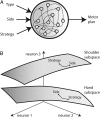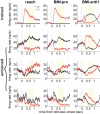From thought to action: The brain-machine interface in posterior parietal cortex
- PMID: 31871144
- PMCID: PMC6936686
- DOI: 10.1073/pnas.1902276116
From thought to action: The brain-machine interface in posterior parietal cortex
Abstract
A dramatic example of translational monkey research is the development of neural prosthetics for assisting paralyzed patients. A neuroprosthesis consists of implanted electrodes that can record the intended movement of a paralyzed part of the body, a computer algorithm that decodes the intended movement, and an assistive device such as a robot limb or computer that is controlled by these intended movement signals. This type of neuroprosthetic system is also referred to as a brain-machine interface (BMI) since it interfaces the brain with an external machine. In this review, we will concentrate on BMIs in which microelectrode recording arrays are implanted in the posterior parietal cortex (PPC), a high-level cortical area in both humans and monkeys that represents intentions to move. This review will first discuss the basic science research performed in healthy monkeys that established PPC as a good source of intention signals. Next, it will describe the first PPC implants in human patients with tetraplegia from spinal cord injury. From these patients the goals of movements could be quickly decoded, and the rich number of action variables found in PPC indicates that it is an appropriate BMI site for a very wide range of neuroprosthetic applications. We will discuss research on learning to use BMIs in monkeys and humans and the advances that are still needed, requiring both monkey and human research to enable BMIs to be readily available in the clinic.
Keywords: brain–machine interface; intention; monkey; posterior parietal cortex; tetraplegia.
Conflict of interest statement
The authors declare no conflict of interest.
Figures





References
-
- Georgopoulos A. P., Higher order motor control. Annu. Rev. Neurosci. 14, 361–377 (1991). - PubMed
-
- Mountcastle V. B., Lynch J. C., Georgopoulos A., Sakata H., Acuna C., Posterior parietal association cortex of the monkey: Command functions for operations within extrapersonal space. J. Neurophysiol. 38, 871–908 (1975). - PubMed
-
- Robinson D. L., Goldberg M. E., Stanton G. B., Parietal association cortex in the primate: Sensory mechanisms and behavioral modulations. J. Neurophysiol. 41, 910–932 (1978). - PubMed
-
- Gnadt J. W., Andersen R. A., Memory related motor planning activity in posterior parietal cortex of macaque. Exp. Brain Res. 70, 216–220 (1988). - PubMed
-
- Snyder L. H., Batista A. P., Andersen R. A., Coding of intention in the posterior parietal cortex. Nature 386, 167–170 (1997). - PubMed
Grants and funding
LinkOut - more resources
Full Text Sources

